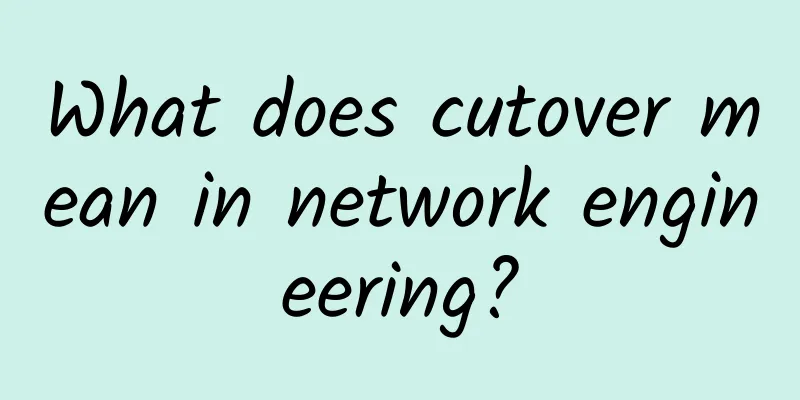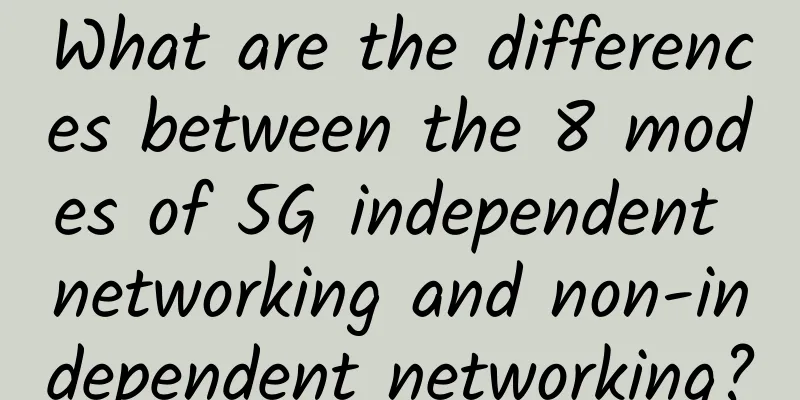What does cutover mean in network engineering?

|
1. Main contents of this article
2. About Network Engineering Business In the network engineering industry, there are many types of business. From a technical perspective (not distinguishing between pre-sales and after-sales), common businesses include:
Therefore, there are many types of technical services in the network engineering industry, which depends on the position, customer requirements, and the company's overall arrangements. 3. Network Cutover I want to make it clear again that the concept of "network" we are discussing here does not refer to small-scale networks such as small home broadband, but large and medium-sized industrial-level networks, such as enterprises, financial institutions, government agencies, large-scale educational campus networks, etc. For small home networks, you can just tinker with them yourself, and at most you won't be able to access the Internet at home. However, networks for industrial, commercial, and business purposes require professional technical services. Suppose we have a client who has just built a new campus, which includes several buildings and covers a wide geographical area. We will not talk about the construction of the campus, but after the campus is built, a dedicated network is definitely needed to carry the company's business traffic. It may be wireless, wired, or a wired and wireless converged network. In any case, a large-scale campus network is definitely needed to carry electronic business interaction data. At least, users in the campus always need to go online, right? If there is a demand for network construction, there will be sales of network products or solutions. Here we will ignore the sales process and assume that all pre-sales and sales processes have been finalized. Then the next step is to implement the new network. After the network is built, generally speaking, there is another part of service delivery, which is to provide customer training. The training content is about the implementation, usage, and maintenance methods of network-related products. Then the network is put into use. During the use process, there may be some small adjustment requirements, such as the addition of VLANs and IP address segments, which is network maintenance. In addition, network failures are inevitable, so fault handling is required. If the network needs to be transformed, upgraded, migrated, or other changes after running for a period of time, and these network operations occur on a network that is carrying business traffic, then this behavior is called cutover. Network cutover may be to adjust the network structure, add or replace network equipment, change lines, change equipment configuration, or other changes required for the network. Network cutover is a relatively difficult operation, especially when dealing with the core networks of operators, finance, government or large enterprises. Every cutover operation needs to be done with great caution, because if the operation fails, the impact will be very bad. Therefore, network cutover has certain requirements on the technology, skills, physical strength, mental strength, experience, etc. of professional engineers. 4. Network Cutover Example Here we will take a look at a typical case, and we will focus on understanding the network cutover behavior. Before the transformation of a network, the network structure is shown in "Before the transformation". It can be seen that the network structure is relatively simple, and there are defects of a single device and a single link. There is no redundancy in the equipment and links. Then after the network has been running for a period of time, the network may often have problems. For example, if the uplink link of the access switch fails, then the users connected to the entire access switch will not be able to access the Internet. The customer then proposed a network transformation requirement, with the overall goal being:
This network may have business traffic being forwarded on it at all times, so the cutover operation needs to fully consider this traffic and possible risks, and make full preparations and communicate fully with customers. Try to make the switch as smooth as possible to reduce the impact on the business. In view of this transformation goal and customer needs, the engineers need to do the following:
Therefore, we can see the following characteristics for network cutover:
5. What should be paid attention to in the cutover plan The plan is just a deliverable of the cutover idea, sometimes it is shown to customers, sometimes it is shown to leaders. Of course, the key is to fully understand the entire cutover process. Generally speaking, a cutover plan will include the following content (of course, it depends on the specific situation):
|
Recommend
China Mobile: More than 560,000 5G base stations have been built
At the 2021 China Mobile Global Partner Conferenc...
What the hell is cross-domain? Do you understand?
[[433686]] Cross-domain is a common topic. Recent...
What is 5G Dual Connectivity?
This is a 4G base station, simple and clean. Howe...
Ruijie Networks releases "Digital Force Awakening Plan"
With the global industrial economy accelerating t...
In 2020, who will break out in the 5G era?
In June 2019, the Ministry of Industry and Inform...
Work together to build a secure network and digital ecosystem
Today, digital transformation led by emerging tec...
Soul-searching question: How many HTTP requests can be sent through a TCP connection?
A classic interview question is what happens from...
Healthcare and smart city services will lead 5G IoT adoption
Juniper Research predicts that by 2026, there wil...
IDC: Global Enterprise WLAN Market Recovered in the Third Quarter with a Growth of 7.4%
According to IDC's Global WLAN Quarterly Trac...
Wu Jian from CommScope: In the future, the two development directions of data centers are centralization and edge computing
【51CTO.com original article】 Do you know how much...
One of the most popular network protocols - LoRaWAN?
Communication and network protocols are an essent...
23 pictures to explain routing protocol: the core technology of computer network
[[421406]] Let me get straight to the point and f...
BudgetVM: Los Angeles/Dallas/Chicago/Japan/Hong Kong dedicated servers starting at $49 per month
BudgetVM is a local data center founded in 2015. ...
Nanchang Wanda City Marketing Secret: Ruijie's "Five-Star" Wi-Fi Makes Every Guest a VIP
Free Wi-Fi is an indispensable service during tra...
12 principles to make data centers perform better
As American football star Tom Brady once said, &q...







![[6.18] OneTechCloud: VPS 30% off monthly payment starting from 19 yuan, Hong Kong CN2/CMI large bandwidth/US CN2 GIA/high defense optional](/upload/images/67cabe9645d50.webp)

